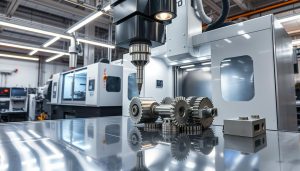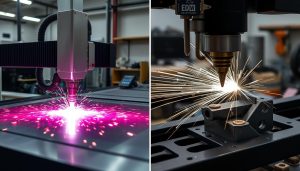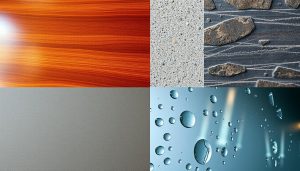In the world of metalworking, the proper surface finishing of 316 stainless steel is a crucial step that can greatly enhance its performance, durability, and aesthetic appeal. This versatile alloy, renowned for its exceptional corrosion resistance and strength, is widely used across a variety of industries, from food processing to medical equipment. By employing specialized surface treatment methods, fabricators and manufacturers can unlock the full potential of 316 stainless steel, ensuring their products not only function at their best but also meet the stringent demands of their respective applications.
Importance of Surface Finishing for 316 Stainless Steel
Proper surface finishing plays a pivotal role in unlocking the full potential of 316 stainless steel. This premium alloy is renowned for its exceptional corrosion resistance, but its performance can be further enhanced through strategic surface treatment. Investing in the right surface finishing techniques not only safeguards the material against environmental threats but also elevates its aesthetic appeal and functional capabilities.
Enhancing Corrosion Resistance
The 316 stainless steel properties make it a popular choice for applications where corrosion resistance is paramount. However, the surface finish can significantly impact its ability to withstand corrosive environments. Processes like electropolishing, passivation, and pickling remove impurities, create a uniform passive layer, and optimize the material’s resistance to pitting, crevice, and stress corrosion.
Aesthetic and Functional Benefits
Beyond corrosion protection, surface finish importance extends to the visual appeal and practical performance of 316 stainless steel. Polishing and buffing techniques can impart a lustrous, mirror-like finish, enhancing the material’s aesthetic appeal. Conversely, textured or matte finishes can be achieved for specific design requirements. Furthermore, surface finishing can improve the material’s resistance to wear, abrasion, and adhesion, making it more suitable for demanding industrial and commercial applications.
Ultimately, the careful selection and implementation of surface finishing techniques are crucial for unlocking the full potential of 316 stainless steel, ensuring its long-term durability, functionality, and visual appeal.
“The quality of the surface finish can make or break the performance of 316 stainless steel in critical applications.”
Common Surface Finishing Techniques for 316 Stainless Steel
When it comes to achieving the desired aesthetic and functional properties for 316 stainless steel, various surface finishing techniques play a crucial role. From enhancing corrosion resistance to improving visual appeal, these techniques offer a wide range of benefits. Let’s explore the most common surface finishing methods used for 316 stainless steel.
Polishing and Buffing
Polishing and buffing are two closely related processes that help create a smooth, reflective surface on 316 stainless steel. Stainless steel polishing involves the use of abrasive materials to remove surface imperfections and impart a glossy finish. Buffing, on the other hand, utilizes soft cloth or leather wheels to further refine the surface, resulting in a mirror-like shine.
Electropolishing
The electropolishing process is a highly effective method for improving the surface quality of 316 stainless steel. This electrochemical process selectively removes microscopic amounts of material from the surface, resulting in a smooth, uniform, and passivated finish. Electropolishing enhances the material’s corrosion resistance and ensures a consistently clean, hygienic surface.
Passivation and Pickling
Passivation techniques and pickling are additional surface finishing methods used for 316 stainless steel. Passivation involves the application of a chemical treatment that helps to form a protective, invisible oxide layer on the surface, further enhancing corrosion resistance. Pickling, on the other hand, is a process that removes surface contaminants and discoloration, leaving the steel with a clean, uniform appearance.
| Surface Finishing Technique | Key Benefits | Typical Applications |
|---|---|---|
| Polishing and Buffing |
|
|
| Electropolishing |
|
|
| Passivation and Pickling |
|
|
By understanding these common surface finishing techniques for 316 stainless steel, you can make an informed decision on the most suitable option for your specific application, taking into account factors such as the desired aesthetic, functional requirements, and overall cost-benefit analysis.
Choosing the Right Surface Finish for Your Application
Selecting the appropriate surface finish for your 316 stainless steel application is a crucial decision that can impact both the functionality and aesthetics of your project. When it comes to surface finish selection, a thorough understanding of the key factors to consider is essential.
Factors to Consider
The environment in which the 316 stainless steel component will be used is a primary factor. Environmental conditions such as exposure to chemicals, heat, or corrosive elements can greatly influence the optimal surface finish. Additionally, the required strength and durability of the component must be taken into account to ensure the finish can withstand the intended use.
The desired appearance of the 316 stainless steel is another important consideration. From a glossy, mirror-like finish to a more matte or textured look, the surface finish can significantly impact the visual appeal of the final product.
Cost vs. Benefit Analysis
When evaluating surface finishing options for your 316 stainless steel applications, it’s essential to conduct a thorough cost-benefit analysis. While some finishes may be more expensive upfront, they may offer superior corrosion resistance, longevity, or aesthetic appeal, ultimately providing greater long-term value.
| Surface Finish | Corrosion Resistance | Appearance | Cost |
|---|---|---|---|
| Polishing | Moderate | Glossy | $$ |
| Electropolishing | Excellent | Mirror-like | $$$ |
| Passivation | High | Matte | $ |
By carefully weighing the factors relevant to your specific 316 stainless steel application, you can make an informed decision that balances the desired performance, appearance, and cost-effectiveness.

Ultimately, the choice of surface finish for your 316 stainless steel application should be tailored to your unique requirements, ensuring optimal functionality, durability, and visual appeal.
Industries That Benefit from 316 Stainless Steel Finishing
When it comes to industries that greatly benefit from the proper surface finishing of 316 stainless steel, the medical device, surgical equipment, food processing, and pharmaceutical sectors stand out. These industries demand the highest standards of hygiene, safety, and performance, and 316 stainless steel, with its exceptional corrosion resistance and durable surface finishes, is the material of choice.
Medical Devices and Surgical Equipment
In the medical field, medical-grade stainless steel is essential for producing a wide range of devices, from surgical instruments to implants. The surface finishing of 316 stainless steel plays a crucial role in ensuring these devices are easy to clean, sterilize, and maintain, meeting the strict sanitation requirements of the industry. Polished and electropolished finishes, for instance, create a smooth, non-porous surface that prevents the buildup of bacteria and contaminants, safeguarding patient health and safety.
Food Processing and Pharmaceutical Equipment
Similarly, the food processing and pharmaceutical industries rely on 316 stainless steel equipment with food-safe surface finishes and pharmaceutical equipment finishing to uphold the highest standards of hygiene and product quality. These industries cannot afford any risk of contamination, making the corrosion resistance and easy-to-clean properties of properly finished 316 stainless steel essential for their operations.
By leveraging the advanced surface finishing techniques available for 316 stainless steel, companies in these critical industries can ensure their equipment meets or exceeds the necessary safety and performance standards, providing their customers with the peace of mind they deserve.

Why Choose Shixinproto for 316 Stainless Steel Surface Finishing?
When it comes to professional stainless steel finishing, Shixinproto stands out as the premier choice. With decades of industry experience and state-of-the-art equipment, Shixinproto delivers unparalleled quality surface treatment for your 316 stainless steel components. Trusted by leading manufacturers across various industries, Shixinproto’s commitment to excellence is evident in every project they undertake.
Shixinproto’s team of skilled technicians and engineers utilize advanced techniques, such as polishing, buffing, electropolishing, and passivation, to enhance the appearance, durability, and corrosion resistance of your 316 stainless steel parts. Whether you’re in the medical, food processing, or pharmaceutical industry, Shixinproto’s diverse services can meet your unique surface finishing requirements with uncompromising precision and attention to detail.
With state-of-the-art equipment and a relentless focus on customer satisfaction, Shixinproto is the preferred choice for businesses seeking the highest quality stainless steel finishing solutions. Discover the Shixinproto difference and let their expertise transform your 316 stainless steel parts into masterpieces of form and function.





